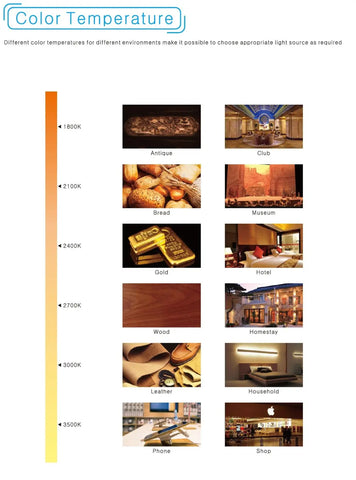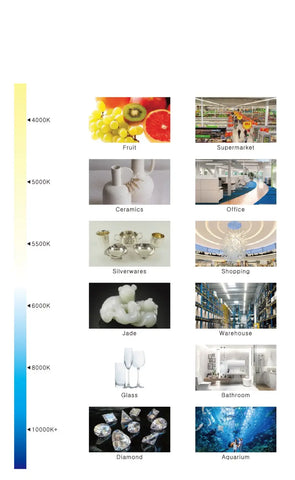- Buy Now
- Help & Guides
- Installs
- Design Enquiries
- Contact Us
- Visit Our Showroom
- Our Story
- Sign in
-
Australia (AUD $)
-
Buy Now
-
Help & Guides
-
Installs
- Design Enquiries
- Contact Us
- Visit Our Showroom
- Our Story
Guide: Different White Colour Temperatures
April 29, 2023
Colour temperature is a measure of the colour appearance of light, which is expressed in Kelvin (K). The colour temperature of white light refers to the warmth or coolness of the light emitted by a source. Lower colour temperatures (1800K-2700K) are considered warm white, while higher colour temperatures (3500K-6500K) are considered cool white.


1800K-2000K: These colour temperatures emit a very warm, yellowish light that is similar to the light emitted by candle flames. This type of light is often used for decorative purposes or to create a cosy and intimate atmosphere in a room. Examples include restaurants, bars, and hotel lobbies that aim to create a relaxed and comfortable ambience. These colour temperatures can also be used in outdoor lighting, such as string lights, to create a warm and inviting atmosphere.
2400K-2700K: These colour temperatures emit a warm white light that resembles the colour of traditional incandescent bulbs. They are often used in residential lighting, such as living rooms, bedrooms, and dining rooms. These environments typically require a warm, comfortable atmosphere. These colour temperatures are also used in restaurants and bars to create a cosy and inviting atmosphere.
3000K: This colour temperature emits a slightly yellowish, warm white light that is commonly used in both residential and commercial lighting. It is often used in kitchens, bathrooms, and offices where a comfortable and relaxing environment is desired. This type of light is also suitable for retail environments, such as clothing stores, where warm lighting can make customers feel comfortable and encourage them to stay longer.
3500K: This colour temperature emits a neutral white light that is often used in commercial settings. It has a slightly yellowish tint, but it is not as intense as lower colour temperatures. Examples of applications include retail stores, hospitals, and schools where a bright, clean environment is desired. This type of light is also used in office environments where workers need to stay alert and focused.
4000K: This colour temperature emits a cool white light with a slight bluish tint. It is commonly used in commercial and industrial settings, such as factories, warehouses, and workshops, where a bright and efficient workspace is desired. This type of light is also suitable for hospitals, laboratories, and other environments where a clean, bright light is needed to perform tasks accurately.
5000K: This colour temperature emits a cool white light that simulates natural daylight. It is often used in offices, hospitals, and schools where a bright and energetic atmosphere is needed. This type of light is also commonly used for outdoor lighting, such as streetlights and parking lots. The high level of brightness provided by this colour temperature makes it an excellent choice for sports facilities.
6500K: This colour temperature emits a very cool, bluish light and is commonly used in applications that require high levels of illumination, such as sports arenas and outdoor lighting. It is also commonly used in industrial and commercial settings where precise work is required, such as in medical labs and clean rooms. This type of light is not suitable for residential settings as it can create a harsh and unwelcoming atmosphere.
In general, the appropriate colour temperature for a given application depends on the specific needs of the user and the environment in which the light will be used. For example, in a residential setting, warmer colour temperatures (2400K-2700K) create a warm and comfortable atmosphere, while cooler colour temperatures (4000K-5000K) are often used in commercial and industrial settings where a bright and efficient workspace is needed. In addition, the choice of colour temperature should also take into account the colour rendering index (CRI), which measures how accurately a light source reproduces colours compared to natural light. A higher CRI is desirable in applications where colour accuracy is important, such as art galleries, clothing stores, and makeup studios.
It is worth noting that the same colour temperature can appear differently depending on the context and surrounding colours. For example, a warm white light (2700K) can appear yellowish in a room with yellow walls, but it may appear more neutral in a room with white walls. Therefore, it is important to consider the overall colour scheme of a space when selecting the appropriate colour temperature.
In conclusion, understanding the different colour temperatures of white light and their characteristics can help users select the appropriate lighting for their needs. Whether it is for creating a cosy and intimate atmosphere in a home or providing bright and efficient lighting in a commercial or industrial setting, choosing the right colour temperature is essential for achieving the desired effect.
Leave a comment
Comments will be approved before showing up.
Also in Extra Low Voltage Lighting Help Center

Brighten Up Your Space: The Magic of Festoon Lighting
January 24, 2025
Discover the enchanting world of festoon lighting! Learn how these twinkling lights can transform any space into a cosy, inviting haven. Perfect for events, homes, and commercial spaces, festoon lighting adds an irresistible charm. Dive into our guide for tips, tricks, and creative inspiration.

The Advantages of Commercial Lighting
January 10, 2025
Discover the advantages of commercial lighting with Flexible Neon's offerings. Explore the longevity, energy efficiency, and aesthetic appeal of festoon lighting, LED floodlights, fairy lights, and LED modules for your projects.

Dot Less Led Strip Archway Nook
January 06, 2025
- FAQs
- Gallery
- Contact Us
- T&Cs
- Delivery
- International Shipping
- Refunds Policy
- Privacy Policy
- Buy now
- Guides
Sign up to get the latest on sales, new releases and more…
© 2025 Flexible Neon.


